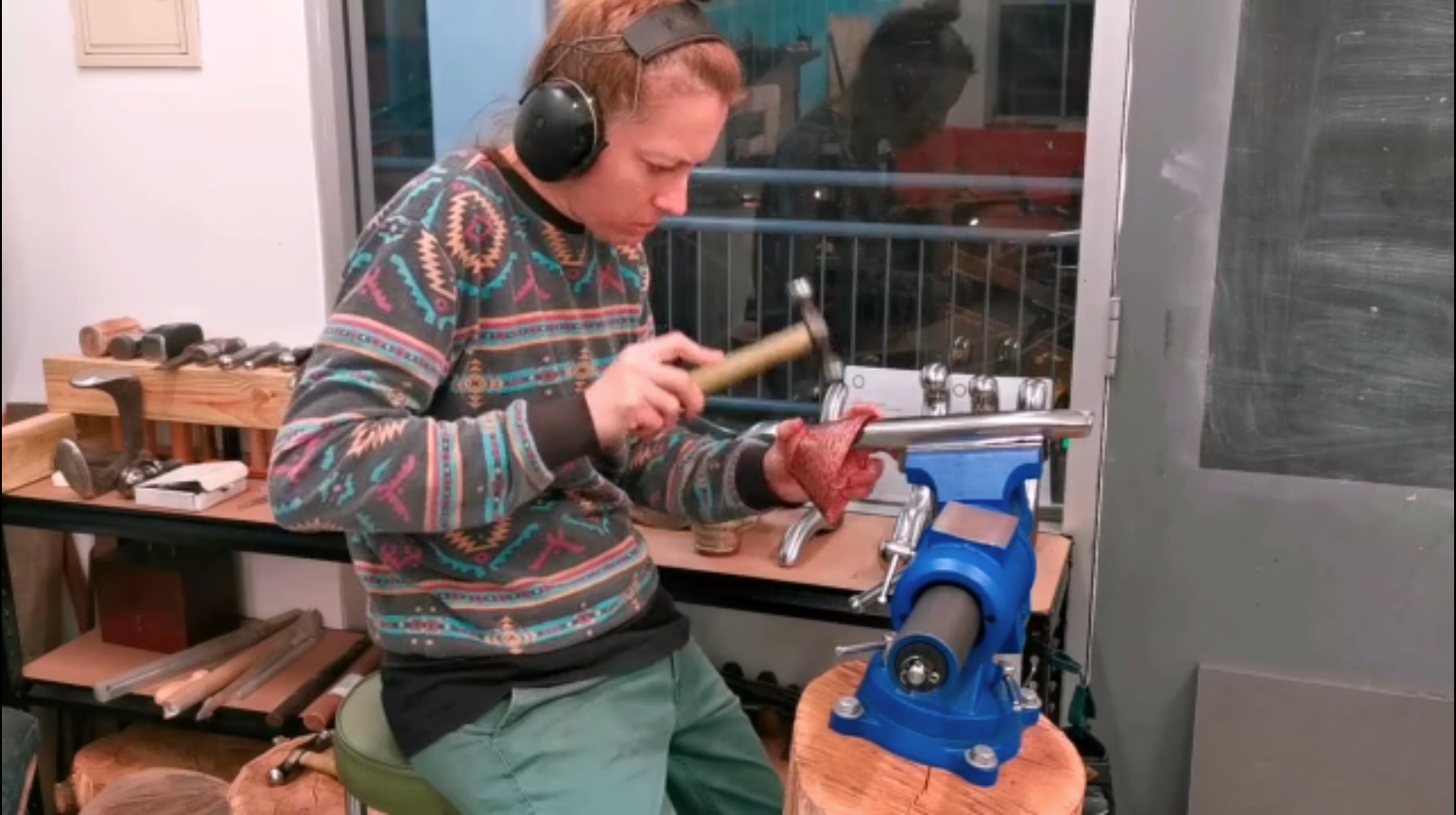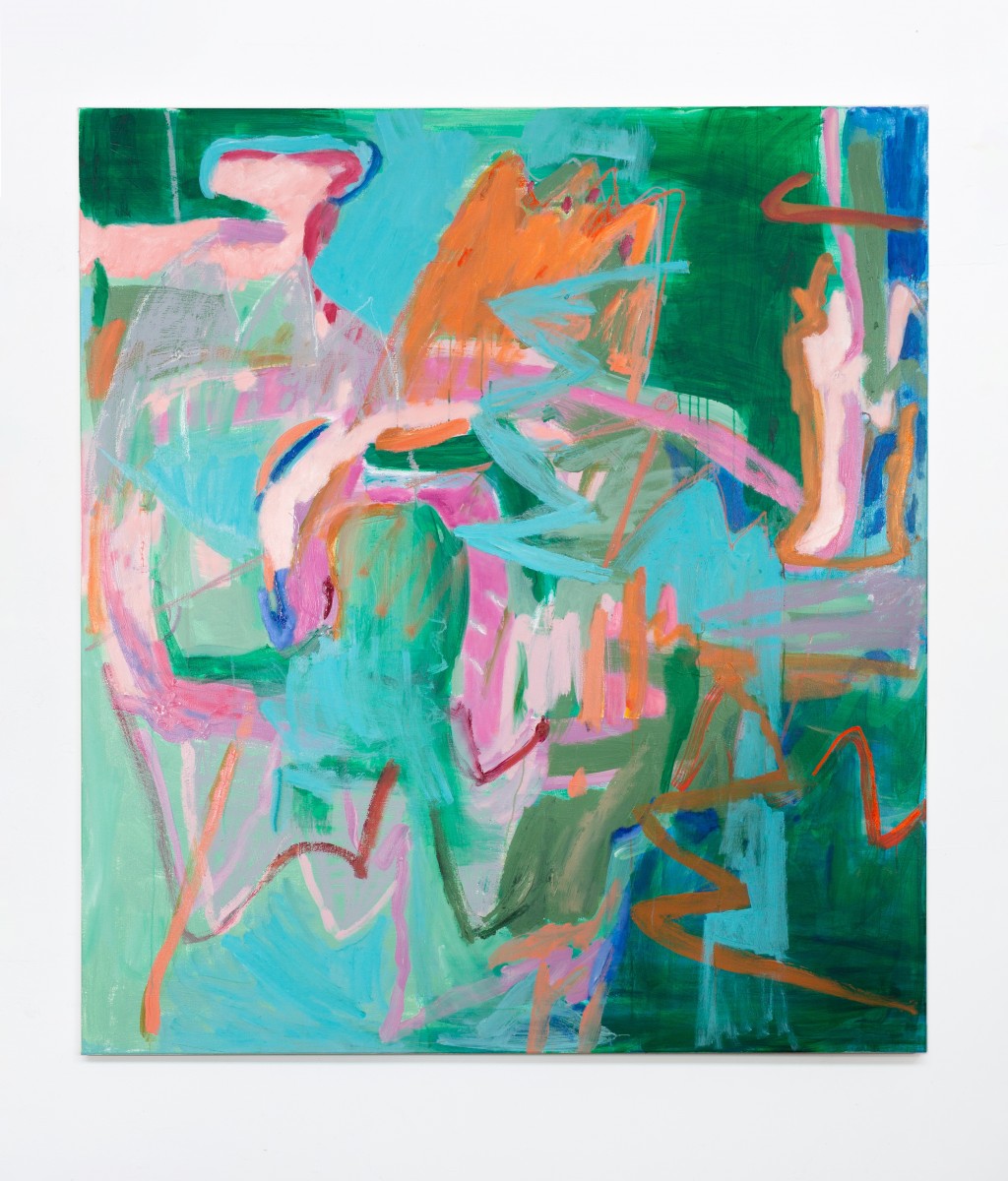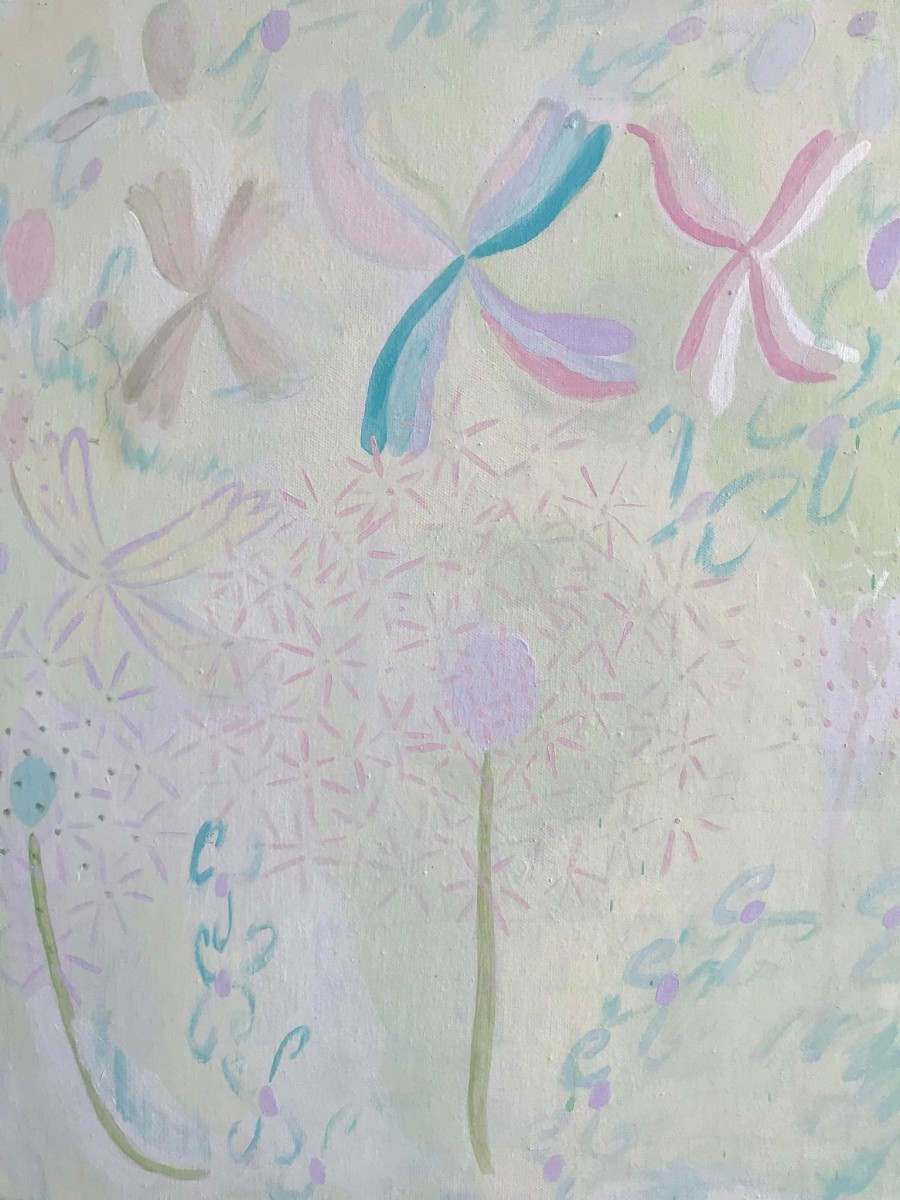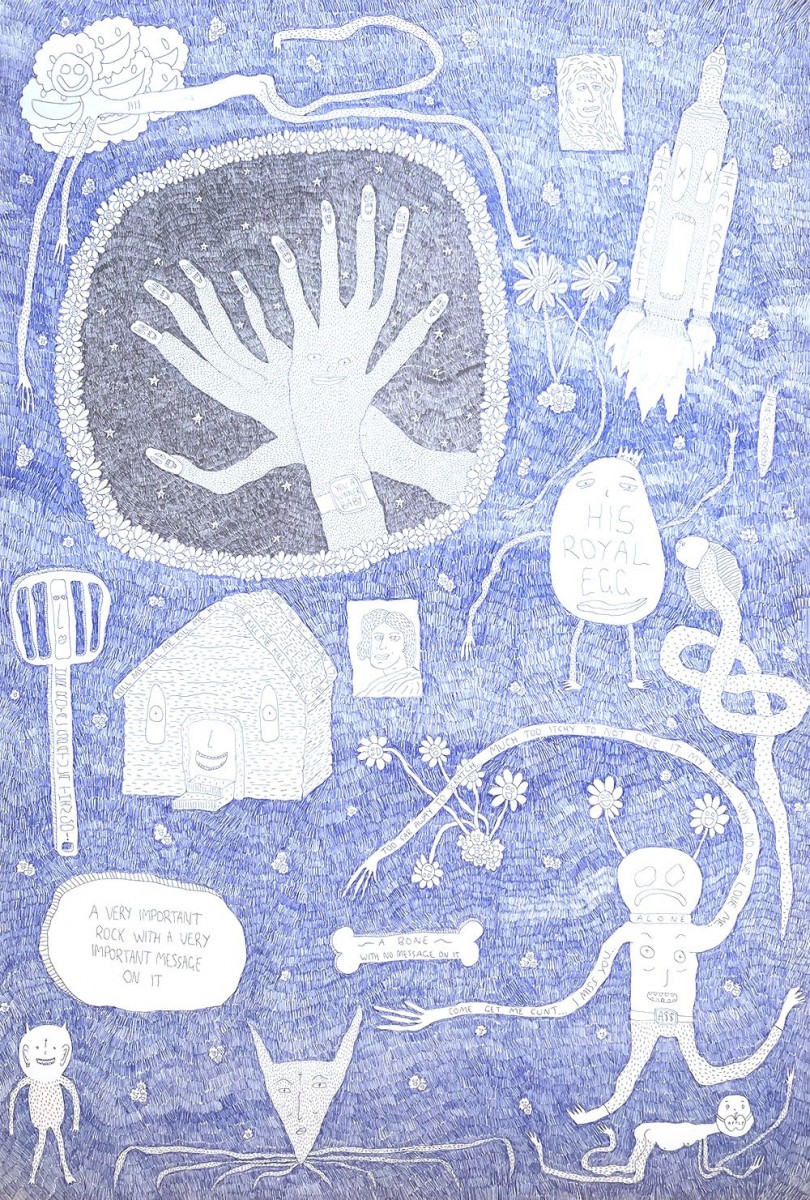Claire Welch’s practice explores the immediacy and unpredictability of mono-printing technique and is interested in unique textural lines and gestural marks. Welch spoke with Claire de Carteret about her most recent work ‘Dog II’ and her print-making process.
de C: Hi Claire, could you talk me through the ideas and process of ‘Dog II’?
W: ‘Dog II’ is the response to the growing development in robotics, in particular robot dogs. Humans have been selectively breeding dogs for thousands of years. Now when we can create machines we fashion them in their likeness.
This print explores these infallible canines infected by organics. What is the point of a robot that can get sick? This conflict is reflected in the marketing and perception of these robots. Robotic dogs are largely marketed playfully, as a fun innovative technology. In truth, these robots are being weaponized, used in war and being tested by police. My print series looks to question our relationship with technology, and how we imprint our organic problems onto objects.
de C: I feel a sense of simplicity and quietness to your mark-making, yet the forms and shapes you make can be quite large and take up the entire
paper? Can you talk about the printmaking process and how it informs the movement in your work?
W: My printmaking process involves covering the plate in ink and then taking it back to create the image. This creates a lot of sweeping motions and then fine detail. Ioften use bits of rag, the end of a paintbrush and q-tips to create the delicate parts of the image. It is difficult to find a balance between the clear structure to the form and interesting mark-making. Additionally, the ink dries rather quickly, so I must move fast so it doesn’t dry out. The forms and shapes take up most space in my prints as I aim to create a sense of confinement. The movement and detail are closed off in a small space, even off the edge of the paper. This is to suggest there is more to see, just out of sight.
|
Claire Welch’s printmaking practice revolves around ambiguous and tense bodily forms. Welch is an emerging artist based in Sydney, Australia. She completed her Bachelor of Fine Arts at the National Art School in 2020 majoring in printmaking. Welch has exhibited in selected group exhibitions, such as 'Rats' at 321 Project Space and 'Luxury Item' at DownUnder space. Welch received the Jocelyn Maughan Sketchbook prize in 2019 and the Bouddi Foundation of the Arts grant in 2016. For any enquiries about Welch’s work please call or email the gallery through 02 93681142 or art@stanleystreetgallery.com.au Stanley Street Gallery acknowledges and respects the Gadigal people as the traditional custodians of the land upon which this interview was conducted. Stanley Street Gallery pays respect to the Elders past, present and emerging. Sovereignty was never ceded. |
|
Gretal Ferguson is a multi-disciplinary object orientated artist interested in the conceptual and technical boundaries of silver-smithing craft.
For our in conversation series, Gretal spoke about the thinking behind her new work, ‘Nailed Down’ and its connection to the history of metalwork and artisanal labor.
Gretal Ferguson: On Metalwork, Artisanal Labor and Process
“Throughout history metalwork has been melted down to create new objects, disregarding the original craftsperson’s hand, most people only seeing value in the material itself. Yet as fewer artisans carry on these skills and traditions, we are in danger of losing the craft completely.
My work explores fear and the dire state of traditional silversmithing education in Australia. With so many iconic institutions being defunded or shut down, there are very few avenues for people to access this knowledge.
‘Nailed Down’ is the physical manifestation of this fear. Created with the intention to resemble the metal in its molten pre-worked state, the laboriously formed objects are left blank and without function, suggesting the growing absence of skills required to work it. Each piece is nailed down in desperation, attempting to prevent these traditions and skills escaping us entirely.
These objects began as a flat sheet of silver and were shaped using the traditional silversmithing technique of raising. This is a process where the metal is repeatedly heated and hammered over several different shaped steel stakes. Each hammer strike on the metal overlaps to ensure the metal compresses evenly, resulting in thousands and thousands of hammer blows to each piece. The stakes I used to shape the metal are also designed and made by me, as they are impossible to buy these days. The steel nails piercing each piece were also forged by hand”.
Gretal Ferguson completed her Masters of Jewellery, Silversmithing, and Related Products at Birmingham City University’s School of Jewellery in the UK. Upon her return to Australia Gretal was accepted into the Associate Program at JamFactory in Adelaide, working out of the Jewellery and Metal Studio where she has had the time and space to develop work for several local and international exhibitions. She has exhibited nationally and internationally.
Gretal’s work is available on our online stockroom. Soupçon will be open until the 5th of March. Private viewings are welcome. For all other enquiries about Gretal’s work please call or email the gallery through 02 93681142 or art@stanleystreetgallery.com.au
Stanley Street Gallery acknowledges and respects the Gadigal people as the traditional custodians of the land upon which this interview was conducted. Stanley Street Gallery pays respect to the Elders past, present and emerging. Sovereignty was never ceded.
Andjana Pachkova is interested in understanding the subtle changes in the human psyche that occur when a person moves through a series of places. Her interest lies in discovering how that mutual interaction of the human being and the landscape shapes both. Andjana spoke with Claire about the significance of moving in water and water movement to the fluidity and energetic marks of her large scale gestural painting, ‘Dreaming of Mullumbimby’. Within her practice, Pachkova is captivated by the never-ending dance of the nature and the human, passionate and loving to be sure, yet mostly violent, and at times exploitative.
de C: Hey Andjana, I hope you are doing well! Can you talk me through the movement in your work, 'Dreaming of Mullumbimby'?
AP: Hey Claire. Movement. Right. How does that saying go? The only constant is the change. And so with the movement, that is theessence of all life, and every aspect of life, whether immediately perceptible to the eye (like water movement) or not (human ageing, landscape erosion). Did you know for instance that while we are sitting comfortably interacting via email, we actually are moving in space with head-spinning speed of 490,000 miles per hour. So, back to movement; I feel like movement really is the core of all energetic transfer. I suppose I paint in a physical way, I move around my studio with a brush loaded with paint and move around the face of the canvas, turn the canvas over many a time. In ‘Dreaming of Mullumbimby', I am using Byron Bay with Mt. Warning's backdrop as a visual inspiration, I am also painting surf. Here is a mind-boggling fact, the waves one rides or the surf one watches are actually a phenomenon of water staying still not moving across the ocean, but actually energy from a distant storms moving through the water while water remains relatively still. I try to communicate energy underlying the landscape through movement.
I feel like movement really is the core of all energetic transfer. I suppose I paint in a physical way, I move around my studio with a brush loaded with paint and move around the face of the canvas, turn the canvas over many a time. de C: Colour and bold mark making occupy substantial space in your work, what is the significance of this?
AP: I am a big fan of tonal work but it is colours that I live and breathe. In this painting, I likely did not do justice to the palette mother nature can create during twilight with the sky and the water rapidly (seemingly) moving. As far as the marks are concerned, I often think of how nature, while exceptionally diverse, nonetheless has a language of creation. Thus for instance, no matter where located, an ocean-scape would often have the same lines, movement of waves - a recognizable pattern. Same with the mountains and their peaks, while there is an infinite variation on the theme, the theme is recognizable. I have been working for some time now on creating a language of my own, working out some signature gesture marks that come naturally from the union of hand, brush, neurons and fire confidently onto the painting surface. I love how varied a touch can be on the canvas and how one can be so intimate with the viewer that way, almost reaching out through the work to communicate the mood through touch.

Andjana (Andy) Pachkova comes from the traditional Russian art tutoring background. Following Perestroika, in the early 1990s, she took classes at Stroganov Moscow State University of Art and Industry, as well as studied with various private tutors. Pachkova has been represented by Stanley Street Gallery since 2017 and Mercury Gallery in Moscow.
For any enquiries about Pachkova’s work please call or email the gallery through 02 93681142 or art@stanleystreetgallery.com.au. Soupçon will be open from the 9th February until the 5th March. Private viewings are welcome.
Stanley Street Gallery acknowledges and respects the Gadigal people as the traditional custodians of the land upon which this interview was conducted. Stanley Street Gallery pays respect to the Elders past, present and emerging. Sovereignty was never ceded.
Lily Golightly is an emerging artist who works across painting, drawing, sculpture, textiles and video. Her work is interested in concepts of collective imagining and fantasy. She is also interested in ideas of make-believe, playfulness and humour. Golightly spoke with Claire de Carteret about how she collages images from nature and those found in fantasy, myth and fairytale to create utopian images in her paintings ‘Dandelion Universe’ and ‘lovesprout’ showing in ‘Soupçon’
de C: I sense a lot of fantasy and magic themes in the works Dandelion Universe and Lovesprout. Can you talk a little bit to what the works mean to you?
LG: Yes I am really inspired by fantastical imagery and the idea of using painting to express fantasy. Dandelion Universe is inspired by my fascination with the shape of dandelions. I think they look like meeting points or universes, the way the layers float by one another on thin stems.
At this time, I was inventing lots of characters for my book of characters and I made the angelbug which I thought may like to fly by the dandelion. I like plants as potential meeting points for insects, ghosts, aliens and all of my made up characters too. I like to place them together somewhere real where I could find them. I also love that dandelions are technically weeds because it means each time I see them it is a surprise and they could be living in very strange urban places. When I see a dandelion I see a magical orb.
Lovesprout was inspired by a crush I had and I was feeling very full and all over the place from meeting this person, in the best best way. I just was having trouble following my train of thoughts and things like that. I really like that feeling of being a bitdumb from a crush or a bit messy, I feel like we are often asked to be so organised and I like how love can disrupt that. Mostly there was a really nice feeling of starting to fall for someone. I invented a little plant that was growing through the chaos called the lovesprout, it felt freeing to plant a little sprout right amidst all the colourful swirling feelings. It feels nice to look at that painting now and think how if I were to paint my current feelings the background would have changed colour and the sprout would be taller.
de C: With your paintings I almost feel like I’m looking through a window or an opening in a wall, can you talk about the significance of portals in your practice?
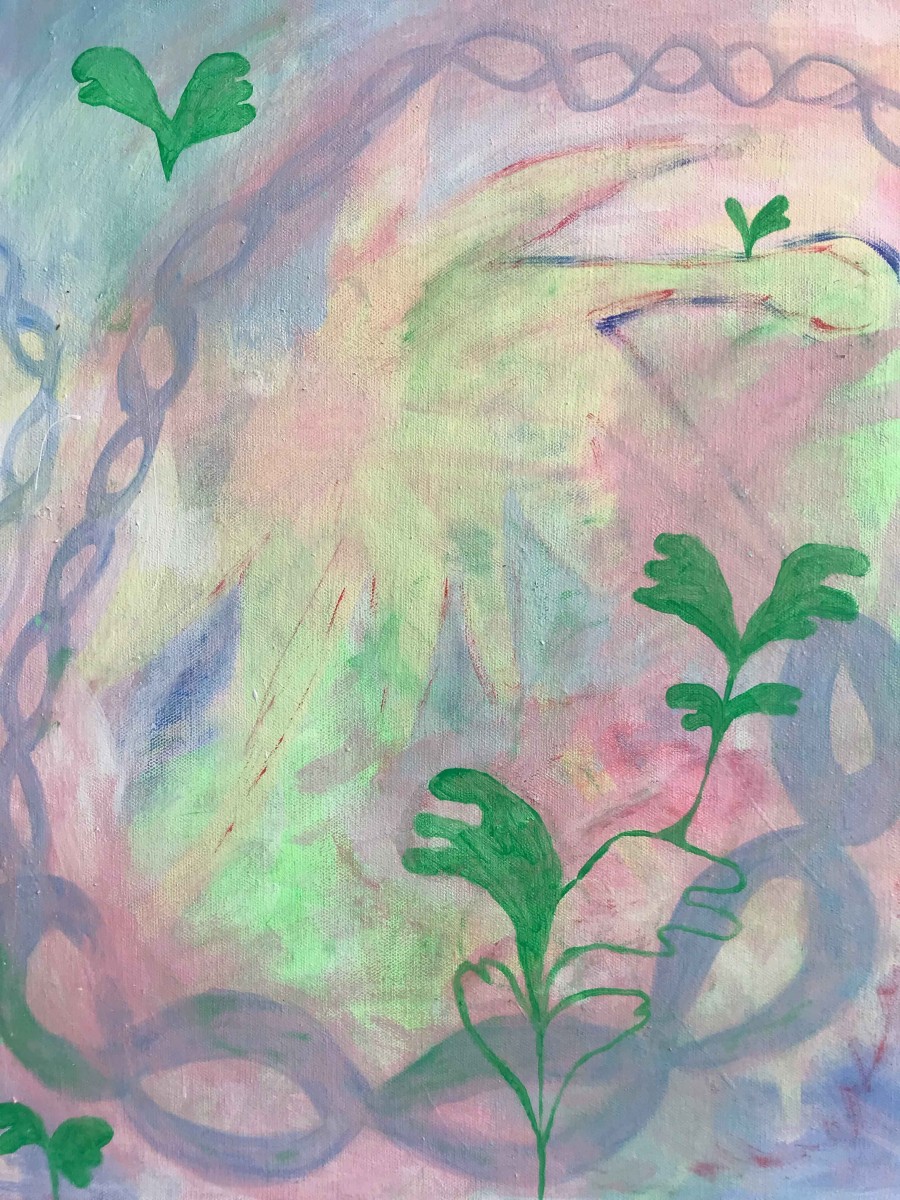
LG: Wow that's so nice thank you! Yes I really love the imagery of portals, windows, doors, any sort of doorway really. I went through a phase of making magical portal paintings, to contact people that I wasn't near anymore and it felt really nice to attempt to make them, but I realised how arrogant it was for me to try to make magicalportals in one year so I decided to really do it, it may be a life long process. In the next series of paintings I made, it sort of became a little more abstract. I realised that every artwork is a portal to another thought or feeling. I have started a series of new paintings inspired by Calvino's Invisible Cities and am using the painting as a way to create a window into these imagined cities, so there are always portals hiding in my works.

Lily Golightly is an artist based in Sydney who works across painting, sculpture, textile, video and drawing. She completed a Bachelor of Fine Arts at UNSW Art & Design in 2018 and will be completing her Honors in 2022. She has exhibited in both Australia and abroad and worked on projects for Carriageworks, Sydney Opera House & The National. She is also the founder of Flower Books.
For any enquiries about Golightly’s work please call or email the gallery through 02 93681142 or art@stanleystreetgallery.com.au. Soupçon will be open from the 9th February until the 5th March. Private viewings are welcome.
Stanley Street Gallery acknowledges and respects the Gadigal people as the traditional custodians of the land upon which this interview was conducted. Stanley Street Gallery pays respect to the Elders past, present and emerging. Sovereignty was never ceded.
Jackson Farley is a multidisciplinary artist living and working on unceded Gadigal land. His practice intertwines narrative and humour to point out the absurdities and pointlessness of fine art definitions and power structures. Using digital media, biro pens and ‘self-care’ pencils, Farley’s work is as sentimental as it is a parody, pondering naïvely on categories of art, medium, and painting process.
In the depths of yet another covid upheaval, Claire and artist Jackson Farley got together to chat about the ideas underpinning his upcoming solo ‘My Very First Ever Painting Show’, Sydney’s first ever exhibition of Pencil-Paintings.
de C: Hey Jackson, how have you been? What’s been going on?
F: Oh heiiii!! I have been very fabo – very lazy omg but good. I am also very excited weoooo maybe the most excited I’ve ever been for a show. It all feels very spooky and new which is a very nice feeling in a roundabout way… The show hasn’t had much conscious inspo tbh haha it came out of lockdown when I was feeling a bit fkd and decided to buy some ‘self-care’ pencils (which I just find so hilarious and yuppie 2016 energy… but alas anything goes during lockdown). They really didn’t help at all but I decided I quite liked physical drawing again after years of a big digital focus and became quite obsessed with how messy and chaotic the whole process was. My lil laptop (my main art tool up until that point) and I broke up and I decided… Jackson… this is when you become a process-based artist and only paint landscapes – you have made it to eternity. The art cannon accepts you. It was absolute bliss.
de C: Can you talk a little more about the ideas that informed the show?
F: I guess this feeling was the inspo for the show – after a few years of editing and re-jigging concepts/finished works, it was a nice feeling to just draw a fuckin hill and call it a day. So, I went and got a studio (the first time ever) to pursue this new found form of artistry. I decided I would become a painter + I went to the art store (somewhere where I never go) and stocked up on Canvas’ + paints. I entered my studio wide eyed and ready to accept this new fate. But th
ere was only one problem. I’m a fuckin shit painter omg they were so bad. Lockdown blues came back and it was all a bit cooked… I was in the studio staring at my shit paintings (one was actually not so bad and is above my bed now) and I felt my lil self-care pencils calling out to me - jackson… redefine the art cannon with subversive self-care pencil paintings made with your subversive self-care pencil pack. Obviously, this was too big of a burden to accept so instead I just decided to draw some very nice drawings.
I’d already thought of the name for the show ‘my very first painting ever show’ so decided to keep it and I’m just gonna call the drawings paintings because that’s very painterly of me and I really don’t think anyone will notice or carede C: What kinds of mediums are you moving towards? What new things are you learning?
F: Ooohhh yes - obvs pencil paintings! We love it so, so, so much. But something nice is happening at the moment – I’ve got back into digital world again but with my new found pencil painting outlook and the whole process feels completely different. It feels a lot more fun and organic.
My approach has been a lot less hands on and who knew this would make my little life a lot easier hah it’s obviously been super tough being separated from family with border closures and just feeling a little isolated all round… but im a fuckin painter now so who cares amirite!?!?
de C: What makes a good friend?
Farley: Someone who puts up with your shit.
de C: What makes a good artist?
Farley: Someone who puts up with their shit (art).
de C: Do you think you’re as good an artist as you are friend?
F: I think I’m a much better friend – I told you I’m bad at painting!

Jackson completed a Bachelor of Visual Arts with First Class Honours at the Sydney College of the Arts in 2017 and was awarded the University Awards for Drawing and Printmedia. He has also studied at the Maryland Institute College of Art in Baltimore, USA and was awarded the China Cultural Centre residency in Chengdu, China in 2017. In 2019, he was selected as a finalist in the Fauvette Loureiro Memorial Artists Travel Scholarship Exhibition and in 2018, was selected for the Blake Prize, The Churchie and for Hatched.
Jackson Farley is exhibiting 'too far away to scratchmuch too itchy to not give it my best', Biro pen painting on cotton rag, sprayed curved frame, in Soupçon. Now on.
For any enquiries about Farley’s please call or email the gallery through 02 93681142 or art@stanleystreetgallery.com.au. Soupçon will be open from the 9th February until the 5th March. Private viewings are welcome.
This interview was conducted between the unceded lands of the Gadigal people. Stanley Street Gallery pays respect to the Elders past, present and emerging. Sovereignty was never ceded.
Julie Blyfield’s artistic practice is poetically informed by Australian botanical specimens and forms. Working with metal-smithing technique, Blyfield, crafts unique and intricate works provocative of the natural world.
Julie spoke with Claire de Carteret about her method of metaphoric interpretation and the technical process behind her ‘Marine’ series, which will be shown in the upcoming exhibition Soupçon.
de C: Hi Julie, can you talk me through the ideas and process of the ‘Marine’ series of works in the upcoming exhibition ‘Soupçon’?
B: Last year, I was fortunate to visit the State Herbarium of South Australia to study the collections of red marine algae found on the southern coastline of Australia. The delicately pressed algae specimens are visually ‘stunning' because of the diversity in the structure, colour, form and texture. In designing these pieces, I began by photographing the specimens, making sketches which were developed into jewellery pieces.
In resolving ideas, I often make quick paper maquettes to spontaneously visualise my new work. I reinterpret what I see using the technique of metal chasing (texturing) rather than try to emulate details from nature. ‘Chasing' is the labour intensive technique of hammering with small steel tools across the annealed (softened) silver surface which is secured in place by ‘pitch’. ‘Chasing' or texturing silver creates pattern, volume and form in the metal.
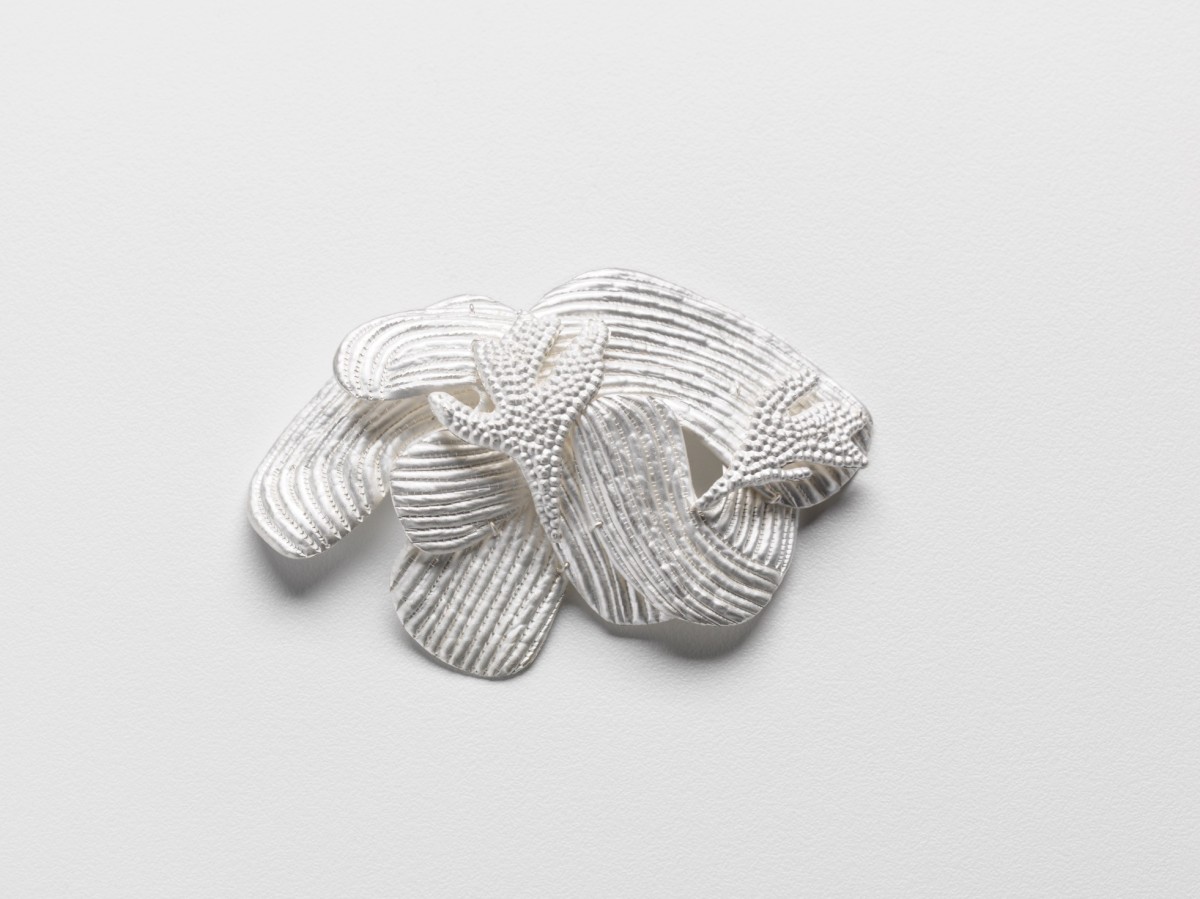

I reinterpret what I see using the technique of metal chasing (texturing) rather than try to emulate details from nature. ‘Chasing' is the labour intensive technique of hammering with small steel tools across the annealed (softened) silver surface which is secured in place by ‘pitch’.de C: Can you talk about the feeling you get towards your subject matter before you start creating work?
B: There is an 'energy’ that comes from creating new work, with a desire to always make something new and different from my previous work, which keeps me motivated and interested! Contemplating new inspiration, I try to look at things with a ‘fresh’ eye and capture the essence of the subject matter and, while working from ‘real life’ I can study the details and intricacies. Creating work is about stimulation, energy and interpretation, and new ways of 'seeing’ and capturing ideas for jewellery pieces.

de C: In a way, your work almost feels archival, what kind of connection do you feel towards the natural world and why is it important for you to express it?
B: I am an avid gardener and I feel connected to my garden and sense of place. The garden is a refuge for me, a place where I spend many hours each week as well as in my studio. There is something calming about spending time with nature, watching plants grow and change as the seasons come and go. I enjoy daily walks around my neighbourhood and this allows me to study the gardens, the diversity and wonders in flora and nature. In my family history my great-grandfather, grandmother and my father were passionate gardeners and I like to think this connects me to them and my place in the world. As a medium, I enjoy the intimate scale and symbolism of jewellery and how different layers of meaning and interpretation can transpire between makers and wearers, continuing over generations and time.

Julie Blyfield work is renowned nationally and internationally. She has pieces in the permanent collections of the National Gallery of Australia, the Musée des Arts Decoratifs in Paris and Victoria & Albert Museum in London. For any enquiries about Blyfield’s please call or email the gallery through 02 93681142 or art@stanleystreetgallery.com.au. Soupçon will be open from the 9th February until the 5th March. Private viewings are welcome.
This interview was conducted between the unceded lands of the Gadigal and Kaurna people. Stanley Street Gallery pays respect to the Elders past, present and emerging. Sovereignty was never ceded.



